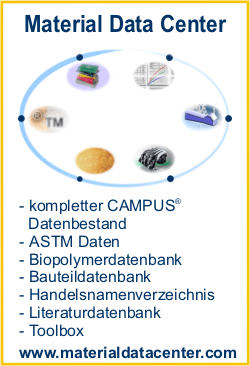
Alle Werkstoffdatenblätter sind frei verfügbar. Kostenlose Registrierung unter www.materialdatacenter.com
Material Data Center ist ein weltweit führendes Informationssystem für Kunststoffe und bietet eine umfangreiche Kunststoffdatenbank, Berechnungsprogramme, CAE Schnittstellen, eine Literaturdatenbank und eine Bauteildatenbank. Für mehr Informationen über Material Data Center besuchen Sie www.materialdatacenter.com.
Dies ist das kostenlose Material Data Center Datenblatt für Ultramid® B3WG13 BK00102 - PA6-GF63 - BASF
Einheitenkonvertierung, PDF Datenblattdruck, direkter Vergleich mit anderen Kunststoffen, Schnapphakenberechnung, Biegebalkenberechnung, CAE Schnittstellen
Hier finden Sie eine Übersicht über weitere Informationen, die Material Data Center zu Ultramid B bietet.
Ultramid® B3WG13 BK00102 is a 63% glass filled, injection molding, high modulus Polyamid designed to have high strength and stiffness for metal replacement applications. It also has excellent moldability and outstanding surface appearance.
Applications:
Potential applications are mirror brackets, fuel lids, gas-assisted steering wheel inserts, ski bindings and bike rack clamps.
| Mechanische Eigenschaften | tr. / kond. | Einheit | Prüfnorm | ||||||||||||||||||||||||||||||||||||||||||||||||||||||||||||||||||||||||||||||||||||||||||||||||
| ISO Daten | |||||||||||||||||||||||||||||||||||||||||||||||||||||||||||||||||||||||||||||||||||||||||||||||||||
| Zug-Modul | 22400 / - | MPa | ISO 527 | ||||||||||||||||||||||||||||||||||||||||||||||||||||||||||||||||||||||||||||||||||||||||||||||||
| Bruchspannung | 235 / - | MPa | ISO 527 | ||||||||||||||||||||||||||||||||||||||||||||||||||||||||||||||||||||||||||||||||||||||||||||||||
| Bruchdehnung | 2 / - | % | ISO 527 | ||||||||||||||||||||||||||||||||||||||||||||||||||||||||||||||||||||||||||||||||||||||||||||||||
| Charpy-Schlagzähigkeit, +23°C | 90 / - | kJ/m² | ISO 179/1eU | ||||||||||||||||||||||||||||||||||||||||||||||||||||||||||||||||||||||||||||||||||||||||||||||||
| Charpy-Schlagzähigkeit, -30°C | 90 / - | kJ/m² | ISO 179/1eU | ||||||||||||||||||||||||||||||||||||||||||||||||||||||||||||||||||||||||||||||||||||||||||||||||
| Charpy-Kerbschlagzähigkeit, +23°C | 15 / - | kJ/m² | ISO 179/1eA | ||||||||||||||||||||||||||||||||||||||||||||||||||||||||||||||||||||||||||||||||||||||||||||||||
| Charpy-Kerbschlagzähigkeit, -30°C | 13 / - | kJ/m² | ISO 179/1eA | ||||||||||||||||||||||||||||||||||||||||||||||||||||||||||||||||||||||||||||||||||||||||||||||||
| Thermische Eigenschaften | tr. / kond. | Einheit | Prüfnorm | ||||||||||||||||||||||||||||||||||||||||||||||||||||||||||||||||||||||||||||||||||||||||||||||||
| ISO Daten | |||||||||||||||||||||||||||||||||||||||||||||||||||||||||||||||||||||||||||||||||||||||||||||||||||
| Schmelztemperatur, 10°C/min | 220 / * | °C | ISO 11357-1/-3 | ||||||||||||||||||||||||||||||||||||||||||||||||||||||||||||||||||||||||||||||||||||||||||||||||
| Formbeständigkeitstemperatur, 1.80 MPa | 214 / * | °C | ISO 75-1/-2 | ||||||||||||||||||||||||||||||||||||||||||||||||||||||||||||||||||||||||||||||||||||||||||||||||
| Brennbarkeit bei nominal 1.5mm | HB / * | class | IEC 60695-11-10 | ||||||||||||||||||||||||||||||||||||||||||||||||||||||||||||||||||||||||||||||||||||||||||||||||
| geprüfte Probekörperdicke | 1.5 / * | mm | - | ||||||||||||||||||||||||||||||||||||||||||||||||||||||||||||||||||||||||||||||||||||||||||||||||
| Yellow Card vorhanden | ja / * | - | - | ||||||||||||||||||||||||||||||||||||||||||||||||||||||||||||||||||||||||||||||||||||||||||||||||
| Brennbarkeit bei Dicke h | HB / * | class | IEC 60695-11-10 | ||||||||||||||||||||||||||||||||||||||||||||||||||||||||||||||||||||||||||||||||||||||||||||||||
| geprüfte Probekörperdicke | 3.0 / * | mm | - | ||||||||||||||||||||||||||||||||||||||||||||||||||||||||||||||||||||||||||||||||||||||||||||||||
| Yellow Card vorhanden | ja / * | - | - | ||||||||||||||||||||||||||||||||||||||||||||||||||||||||||||||||||||||||||||||||||||||||||||||||
| Andere Eigenschaften | tr. / kond. | Einheit | Prüfnorm |
| Dichte | 1740 / - | kg/m³ | ISO 1183 |
| Verarbeitungsempfehlungen Spritzguss | Wert | Einheit | Prüfnorm |
| Vortrocknung - Temperatur | 80 | °C | - |
| Verarbeitungsfeuchte | ≤0.03 | % | - |
| Massetemperatur | 300 - 320 | °C | - |
| Werkzeugtemperatur | 80 - 95 | °C | - |
Max. Water content: 0.03%
Although Product is supplied in sealed containers, drying is recommended in applications requiring optimum surface aesthetics. A dehumidifying or desiccant dryer operating at 80 °C (176 °F) is recommended. Drying time is dependent on moisture level.
Further information concerning safe handling procedures can be obtained from the Material Safety Data Sheet. Alternatively, please contact your BASF representative.
PROCESSING
Melt Temperature 300-320 °C (572-608 °F)
Mold Temperature 80-95 °C (176-203 °F)
Injection and Packing Pressure 35-125 bar (500-1500psi)
Rear Zone 275-300 °C (527-572 °F)
Center Zone 285-310 °C (545-590 °F)
Front Zone 300-325 °C (572-617 °F)
Nozzle 300-325 °C (572-617 °F)
This product can be processed over a wide range of mold temperatures; however, for applications where aesthetics arecritical, a mold surface temperature of 80-95 °C (176-203 °F) is required.
Injection pressure controls the filling of the part and should be applied for 90% of ram travel. Packing pressure affects the final part and can be used effectively in controlling sink marks and shrinkage. It should be applied and maintained until the gate area is completely frozen off.
Back pressure can be utilized to provide uniform melt consistency and reduce trapped air and gas. A maximum of 3.5 bar (50 psi) is recommended to minimize glass fiber breakage.
Fast fill rates are recommended to insure uniform melt delivery to the cavity and prevent premature freezing. Surface appearance is directly affected by injection rate.
Material Data Center wird von M-Base Engineering + Software GmbH angeboten. M-Base Engineering + Software GmbH übernimmt keinerlei Gewährleistung, dass das System fehlerfrei ist. Jegliche Entscheidung über die Anwendung von Werkstoffen muss mit dem jeweiligen Produzenten einzeln abgeklärt werden.
Weiterführende Informationen zu diesem Material wie Stoffgruppe, Herstelleradresse, evtl. auch Datenblätter und Anwendungsbeispiele finden Sie auf www.materialdatacenter.com. Ein Teil der Informationen sind registrierten Nutzern vorbehalten. Auf der Startseite finden Sie einen Link zur kostenlosen Registrierung.












